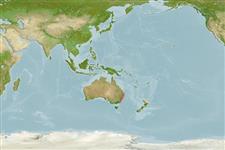Elasmobranchii (Haie und Rochen) (sharks and rays) >
Myliobatiformes (Stingrays) >
Urolophidae (Round rays)
Etymology: Trygonoptera: Greek, trygon = a sting ray + Greek, pteron = wing, fin (Ref. 45335).
More on authors: Müller & Henle.
Environment: milieu / climate zone / depth range / distribution range
Ökologie
seewasser; brackwasser demersal; tiefenbereich ? - 135 m (Ref. 9863), usually ? - 60 m (Ref. 9863). Temperate; 26°S - 38°S
Western Pacific: southern Queensland to New South Wales.
Length at first maturity / Size / Gewicht / Alter
Maturity: Lm ?, range 41 - 42.7 cm
Max length : 47.0 cm TL Männchen/unbestimmt; (Ref. 9863)
Found in sandy beaches and reefs but also well offshore. May venture well upstream in estuaries (Ref. 6871). Feeds on worms, crustaceans, bony fishes, and other stingarees (Ref. 12951).
Life cycle and mating behavior
Geschlechtsreife | Fortpflanzung | Ablaichen | Eier | Fecundity | Larven
Compagno, L.J.V., 1999. Checklist of living elasmobranchs. p. 471-498. In W.C. Hamlett (ed.) Sharks, skates, and rays: the biology of elasmobranch fishes. Johns Hopkins University Press, Maryland. (Ref. 35766)
IUCN Rote Liste Status (Ref. 130435: Version 2024-1)
Bedrohung für Menschen
Harmless
Nutzung durch Menschen
Tools
Zusatzinformationen
Download XML
Internet Quellen
Estimates based on models
Preferred temperature (Ref.
123201): 17.1 - 24.1, mean 18.2 °C (based on 40 cells).
Phylogenetic diversity index (Ref.
82804): PD
50 = 0.5156 [Uniqueness, from 0.5 = low to 2.0 = high].
Bayesian length-weight: a=0.00813 (0.00372 - 0.01775), b=3.08 (2.88 - 3.28), in cm total length, based on LWR estimates for this (Sub)family-body shape (Ref.
93245).
Trophic level (Ref.
69278): 3.8 ±0.59 se; based on food items.
Widerstandsfähigkeit (Ref.
120179): niedrig, Verdopplung der Population dauert 4,5 - 14 Jahre. (Assuming fecundity<100).
Fishing Vulnerability (Ref.
59153): Moderate vulnerability (37 of 100).
Nutrients (Ref.
124155): Calcium = 7.7 [1.1, 139.9] mg/100g; Iron = 0.255 [0.025, 2.936] mg/100g; Protein = 20.1 [14.8, 25.3] %; Omega3 = 0.43 [0.13, 1.30] g/100g; Selenium = 8.78 [1.70, 44.63] μg/100g; VitaminA = 9.32 [0.81, 102.75] μg/100g; Zinc = 0.528 [0.041, 5.686] mg/100g (wet weight);
